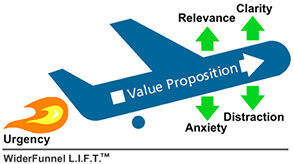
How do you know which of these factors has the greatest impact on conversion for YOUR website?
The answer is YOU DON'T ...until you start testing.
Yes, best practices can be a great place to start, but only after a solid theory has been presented about what is influencing your particular visitors or customers the most (your customer theory).
Our trained CRO experts with lots of testing experience can get lifts right out of the gate, but the biggest improvements typically come AFTER the initial round of tests. Why? Because we can start to identify the factors that appear to be having the biggest impact on conversion and then focus our suite of CRO techniques on THOSE factors. It's not enough to ask users what they want or think, you have to see what they actually DO.
When you do that in the context of a customer theory, every test is valuable - whether it lifts conversion or not. Because eventually you will validate what you think you know about your visitors, and with a validated customer theory you will be able to focus on the factors that truly are having the most impact on conversion.










